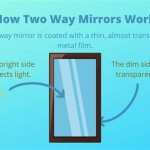What Type of Image Does a Convex Mirror Produce?
Convex mirrors, characterized by their outward curvature, are renowned for their ability to provide a wide field of view. This unique characteristic makes them invaluable in various applications, from security mirrors in shops to side-view mirrors in vehicles. Understanding the type of image a convex mirror produces is crucial for utilizing these mirrors effectively.
Virtual Images
Convex mirrors always produce virtual images. A virtual image is formed when reflected light rays appear to diverge from a point behind the mirror. Unlike real images, which can be projected onto a screen, virtual images cannot be physically captured. They are perceived by the observer due to the brain's interpretation of the diverging light rays.
Diminished Images
The images formed by convex mirrors are always diminished, meaning they are smaller than the actual object being reflected. This reduction in size is directly related to the diverging nature of the reflected light rays. As these rays spread outwards, the image they appear to form shrinks proportionally.
Upright Images
Another key characteristic of images formed by convex mirrors is their upright orientation. This means that the image appears in the same vertical orientation as the object. This aspect distinguishes convex mirrors from concave mirrors, which can produce inverted (upside-down) images under specific conditions.
Wider Field of View
The curvature of a convex mirror allows it to reflect light rays from a wider angle than a flat mirror. This results in a larger field of view, enabling the observer to see a broader area. This characteristic is particularly useful in applications like rearview mirrors, where a wider view enhances safety by reducing blind spots.
Location of the Image
The virtual image formed by a convex mirror is always located behind the mirror's surface. This placement is a consequence of the diverging reflected rays, which never actually converge in front of the mirror. The image appears to reside at the point where these diverging rays seem to originate from when traced back.
The Role of Focal Length
The focal length of a convex mirror is a negative value, signifying its diverging nature. While the focal point is a theoretical location behind the mirror, it plays a crucial role in determining the size and location of the virtual image. A shorter focal length (larger curvature) leads to a smaller and closer image, while a longer focal length (smaller curvature) results in a larger and more distant image.
Applications of Convex Mirrors
The unique optical properties of convex mirrors make them suitable for a range of applications. In vehicles, they serve as side and rearview mirrors, providing a wider perspective of the surroundings. Security mirrors in shops deter theft by allowing staff to monitor a larger area. Convex mirrors also find applications in large telescopes and streetlight reflectors, demonstrating their versatility in manipulating light.
Image Formation and Ray Diagrams
Understanding the formation of images in convex mirrors can be facilitated by using ray diagrams. These diagrams utilize specific rules regarding incident and reflected rays to visually depict the image formation process. Typically, two rays are drawn: one parallel to the principal axis (which reflects as if originating from the focal point) and one passing through the center of curvature (which reflects back along the same path). The intersection of these reflected rays (or their extensions behind the mirror) determines the location and size of the virtual image.
Comparing Convex and Concave Mirrors
Contrasting convex mirrors with concave mirrors highlights their fundamental differences. While convex mirrors diverge light and produce virtual, diminished, and upright images, concave mirrors converge light. Concave mirrors can create both real and virtual images, depending on the object's distance from the mirror. They can also produce magnified or diminished images, and even inverted images, showcasing their diverse image-forming capabilities.
Can A Convex Mirror Produce Real Image
Can A Convex Mirror Form Magnified Image Quora

Concave Mirrors And Convex Image Formation Ray Diagram

Can A Convex Mirror Produce Real Image When The Object Is Virtual And Vice Versa Concave If Yes How Will It Be Possible Why Quora
Can A Convex Mirror Produce Real Image When The Object Is Virtual And Vice Versa Concave If Yes How Will It Be Possible Why Quora

Convex Mirror Uses Of Definition Equation

Convex Mirror Image Formation Conditions Ray Diagram Uses

Image Formation By Convex Mirrors

Convex Mirror Definition Equation Examples Lesson Study Com
Can Convex Mirrors Produce Lateral Inversion Quora








